In The Library
Science You Can Eat
Gates, S. (2019). Science You Can Eat: Edible experiments for hungry minds. Great Britain: DK Publishing.
This how-to book has 20 science experiments, providing recipes with the science behind how it works and historical facts. Science You Can Eat answers common food-related questions, like 'why do onions make us cry?' and uses these questions to discuss broader science concepts, like plant defenses. The book has photographs of stages in recipes with numbers showing the steps, and bright colours, cartoons and highlighted circles to draw attention to interesting information. The layout is attractive and text is broken up into bite-sized chunks. Great to read but more fun to do the experiments included.
Ellie, Engineer
Pearce, J., & Mourning, T. (2018). Ellie, Engineer. New York, New York: Bloomsbury.
This fun read from the Premier's Reading Challenge is the first in a series featuring a kind, inventive and imaginative character in Ellie. In this early chapter book, Ellie and her best friend Kit invent things together, like a water balloon launcher so they can soak the noisy boys. Ellie plans to make a dog-house for Kit as a birthday surprise, with help from the boy and girl groups of friends in her neighbourhood. There are diagrams of inventions throughout the book, which appear to be drawn by Ellie 'herself': illustrator Tuesday Mourning. An appendix includes background materials on tools they used. This book has strong themes of friendship, showing that great things can be achieved by working together.
At the Bottom of the World
Nye, B., Mone, G., & Iluzada, N. (2017). At the bottom of the world (Jack and the geniuses). New York: Amulet Books.
In this early chapter book, a boy named Jack lives with his two genius foster siblings, who enjoy inventing robots. When their drone flies into the neighbour's backyard, they are invited, on the strength of the geniuses' inventions, to come to Antarctica to meet a scientist working there. Unfortunately, the scientist goes missing and it's up to Jack and his siblings to solve the mystery before an Antarctic storm sweeps in! All inventions shown in this fun adventure story are based on real science, and the book naturally slips in the science as part of the story. While Jack isn't a genius in the same way as his siblings, he has his own strengths and uses them to help save the scientist. Included in the Premier's Reading Challenge.
Click'd
Stone, T. I. (2017). Click'd. Los Angeles, CA: Disney-Hyperion.
Allie, a seventh-grader makes an app for finding friends based on common interests while at a summer coding camp and enters it in a competition, hoping to beat her rival coder, Nathan. When Allie shares it with her school friends, she discovers it has a bug: oversharing personal information, putting friendships on the line. Can she accept Nathan's help to fix the app, or is he trying to sabotage her? The first in a series, Click'd is great for fans of Diary of a Wimpy Kid, who like reading realistic books about characters slightly older than themselves in far-off places. The book has some illustrations of the app, adding to the realism of the book.
STEM Bridges Kit
Call number: JKIT< br/>This kit, sponsored by the local university's engineering department, contains the K'Nex Education Introduction to Structures: Bridges set (207 pieces). Also in the kit are the K'Nex Education Teacher's Guide, K'Nex Education Building Instructions, a set of 54 hexagram weights to test your child's structures and the book Latham, D., & Vaughn, J. (2012). Bridges and tunnels: Investigate feats of engineering with 25 projects. White River Junction, VT: Nomad Press, a book for ages 9 and up with various bridge building experiments using common household equipment to give ideas of what to do with the K'nex pieces.
Code your own knight adventure : code with Sir Percival and discover the book of spells
Wainewright, M. (2017). Code your own knight adventure: Code with Sir Percival and discover the Book of Spells. London: QED Publishing.
This graphic novel how to book shows kids how to use the Scratch programming language to code their own video games, with colourful step-by-step instructions and breakouts for key coding concepts. An easy, kid-friendly start to coding, this book is one in a series that covers similar topics. If your child enjoys pirates or space adventures, the other books in the series are worth a look at, too.
SCOPE TV show: streaming
CSIRO (Writer), & Crotty, T., Harris, J., Murray, L., & Elliot, S. (Producers). (n.d.). SCOPE [Television series]. Sydney, NSW: 10 Peach. Streaming access: tenplay.com.au
This Australian TV show airs on 10 Peach and is co-produced by CSIRO, and a new fourth season is currently airing. This fun series has a variety of experiments for kids to try, which can be performed using readily available household materials, explains the science behind everyday life, such as the physics of waterslides, and showcases new and exciting developments in science, right around Australia. SCOPE also visits universities to borrow their resources for extra-exciting experiments.
Double Helix magazine
CSIRO. (2015-present). Double Helix.
This Australian magazine is published by CSIRO and comes out every three months, with a variety of experiments and science journalism, recipes, comics, contests and puzzles and upcoming events to enjoy. Readers can write letters in to the editor and share photos with others. It is an easy and fun read, if they are already interested in science topics or if they are simply curious. It also includes an Indigenous Science column with science being used by Indigenous people to solve problems across Australia: for example, recycling plastic to make 3D printing raw materials.
Prime Climb board game
Math for Love. (2014). Prime Climb. Retrieved from https://primeclimbgame.com/
This board game is for two to four players, aged 10+ (but can be played with simplified rules for younger players) and the object of the game is to roll the dice and add, multiply, divide or subtract from the place your pawns are on to get to the finish: 101. For younger players, operations can be limited to addition or subtraction, and the places are colour-coded to make it easier to play, using the colours instead of the maths. This game with a combination of luck and skill is great to spark the competitive spirit of play in children and adults alike.
Fractions in Disguise
Einhorn, E., & Clark, D. (2014). Fractions in disguise: A math adventure (Charlesbridge Math Adventures). Watertown, MA: Charlesbridge.
This advanced picturebook has an engaging story about a boy who collects fractions, and has to invent a Reducer machine to find the valuable 5/9 fraction, which has been hidden as a larger fraction: but which of his rivals took the fraction? Simple, colourful and bright illustrations help to ramp up the stakes and explain the maths in this entertaining tale, which is studded with fraction puns throughout. An appendix recaps how to reduce fractions.
Websites
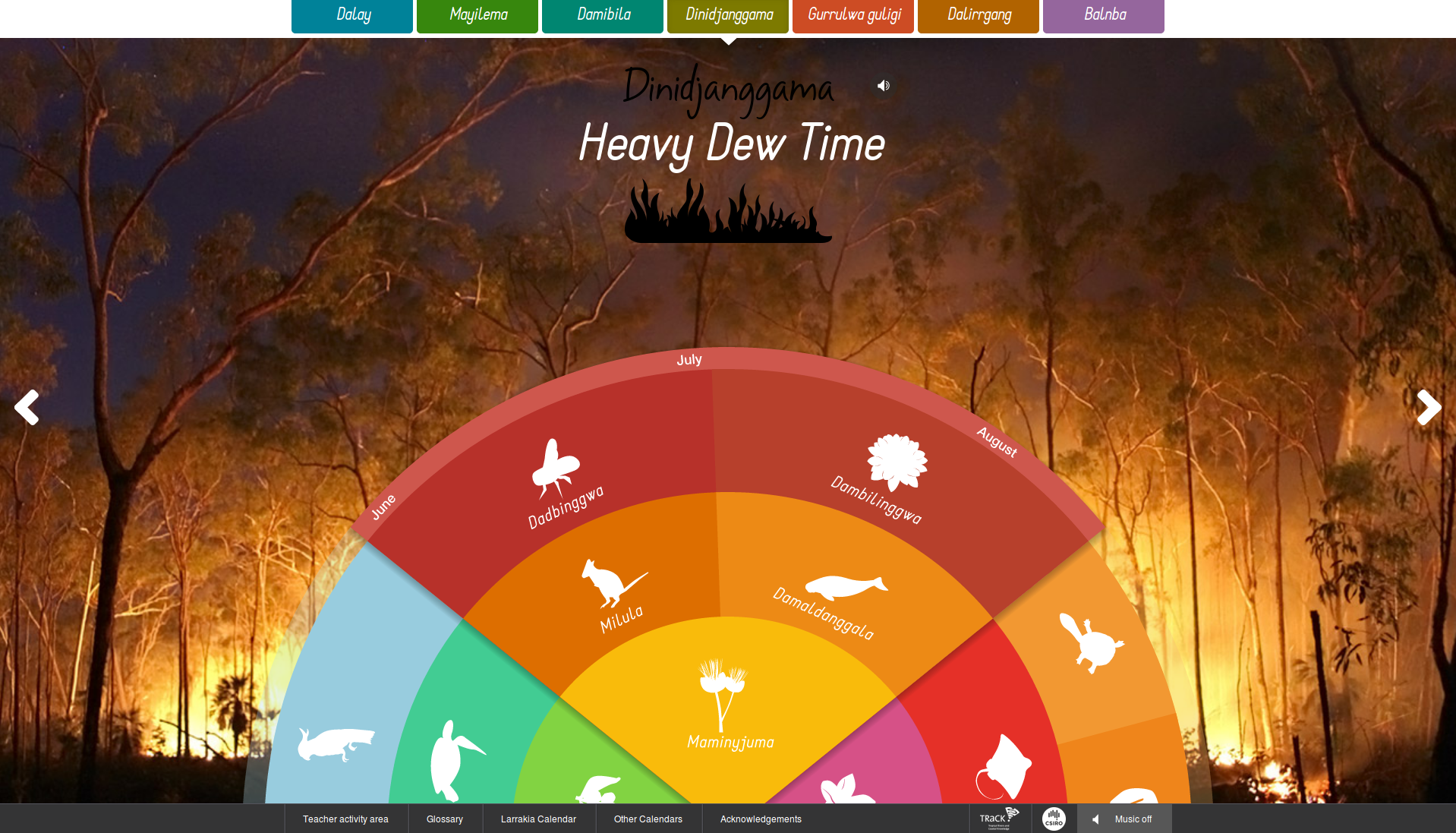
Gulumoerrgin/Larrakia Seasons online interactive calendar
http://www.larrakia.csiro.au/#/calendar/damibila
This website presents calendars used by Indigenous Australians, showing that the seasonal markers were divided by the availability of fruits and animals as well as the weather. Different calendars are shown for different language groups across the Northern Territory, and can be a good way to explore the local natural world. The calendars are presented in a wheel, with the English months on the rim and different colours for different seasons, with the wedges split into different subjects, represented by icons in silhouette that allow for guessing what the icons represent. Animations are played as the user changes the wheel to different seasons, representing what the Indigenous name of the season is. There are pop-up texts and interesting photographs, and sound clips of the Indigenous names can be played. The text is fairly short and is written at a level that children can understand with a grownup's help.
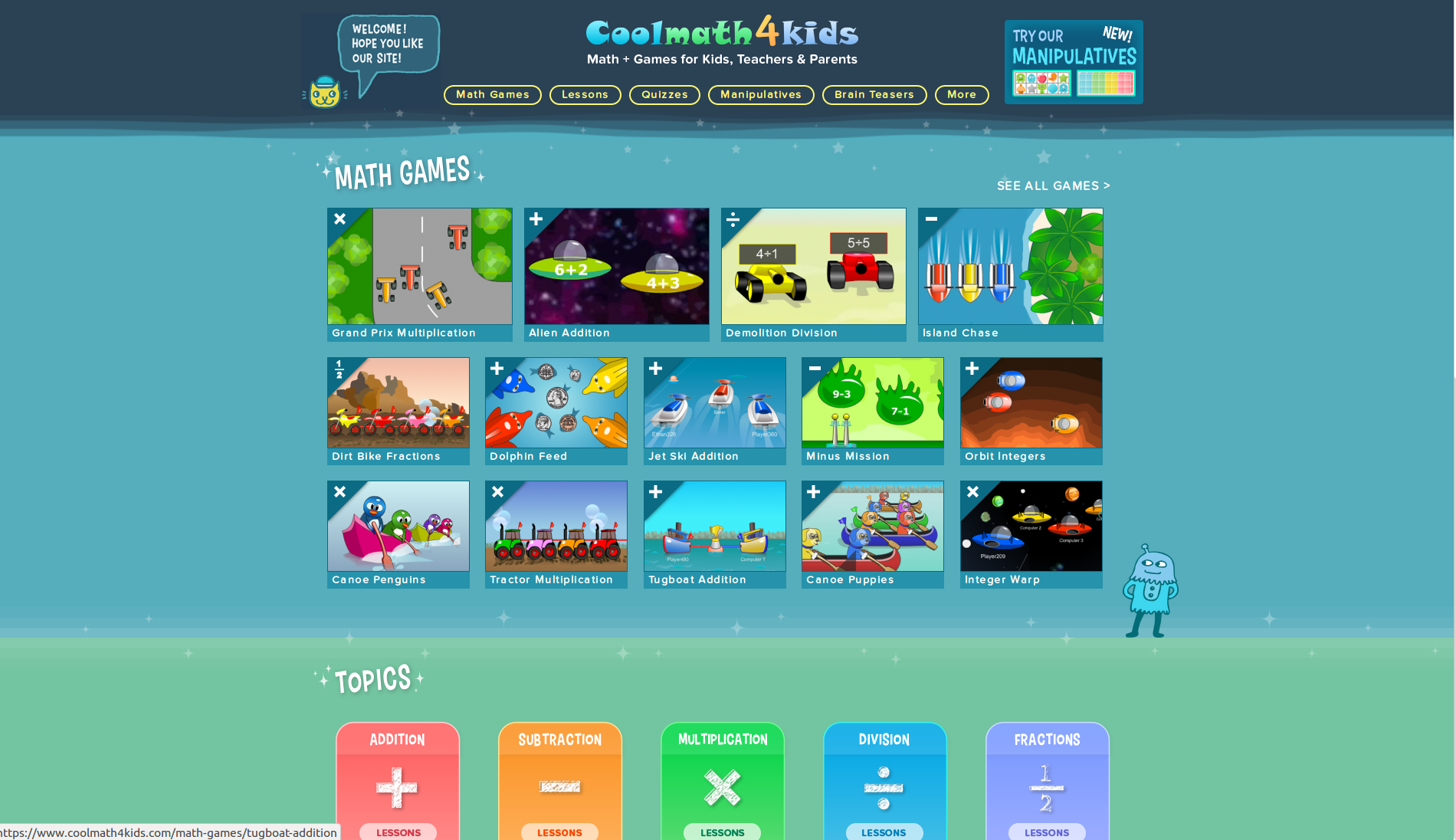
Cool Math 4 Kids
https://www.coolmath4kids.com/
This United States-based website has a variety of interactive maths games to help drill addition, multiplication, division and subtraction. Games can be chosen based on what skill is needed to be practiced or on what looks like fun. There are aliens invading, speedcars racing, tanks crushing, dolphins feeding, penguins paddling, puppies canoeing, jetskis, planets and more! All games are colourful, have action, with sounds to accompany the action and provide feedback to players. There is no known author or publisher for this site, but it has been online since 1997. While children can enter their names to be placed on a temporary leaderboard, the privacy policy states that this is not retained.
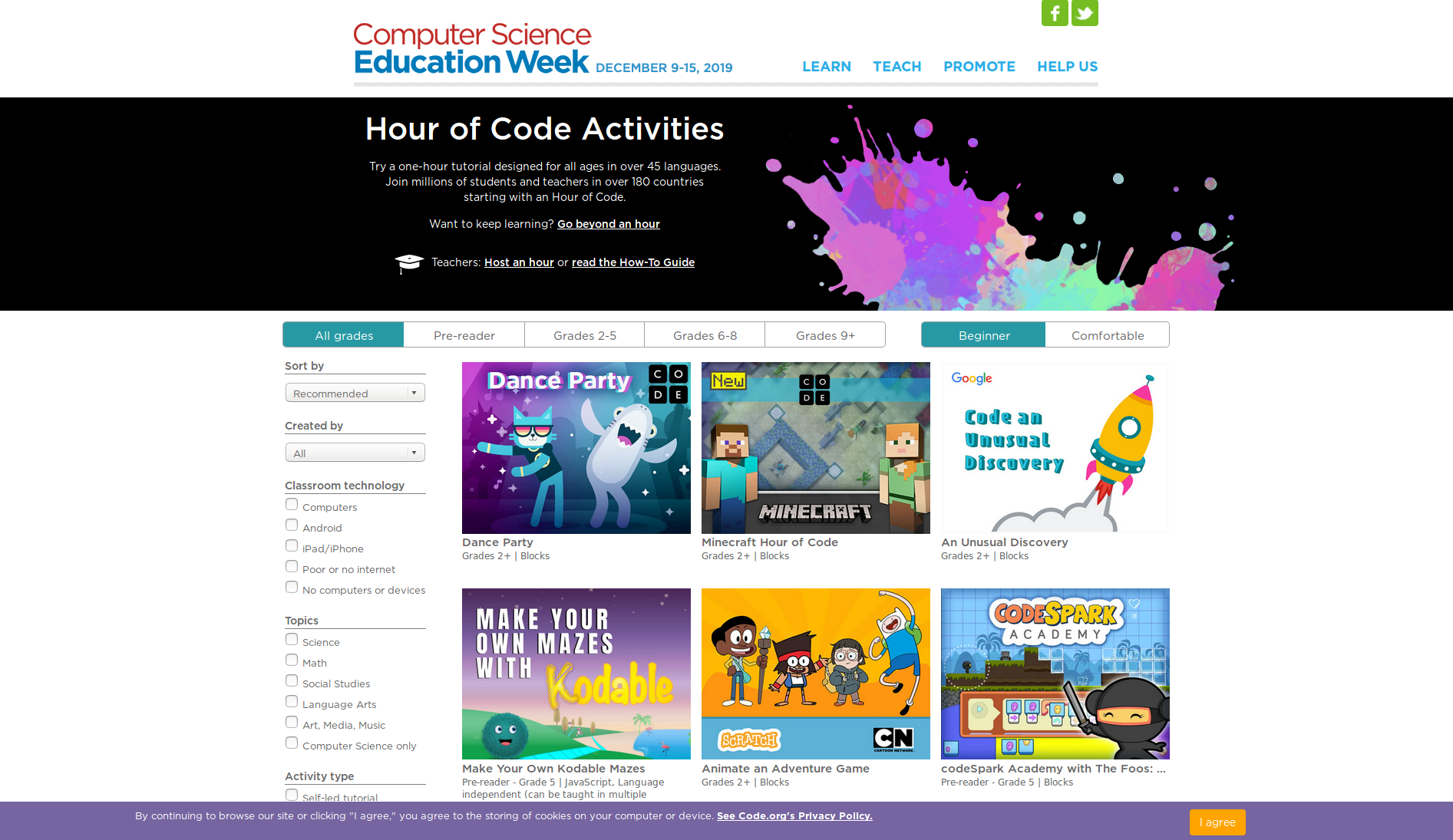
Computer Science Education Week
This US-based website has a wide variety of activities designed to teach students from kindergarten to year 9 how to code their own games. Dfferent genres of game are offered, for example, having an Elsa character from Frozen and making her skate in a particular pattern to create a design, or a side-scroller platform game like Flappy Bird. The lessons are presented using real coding languages, such as Scratch for younger children and Python, Lua and JavaScript for older children. Lessons can be found based on age groupings and whether the child is a beginner or is already comfortable with coding. The hundreds of coding projects on offer deal with a wide variety of subjects, such as literature, politics and different branches of science, art, music, sport, robots, engineering, online digital safety, virtual worlds, fireworks, encryption, animation and much more.
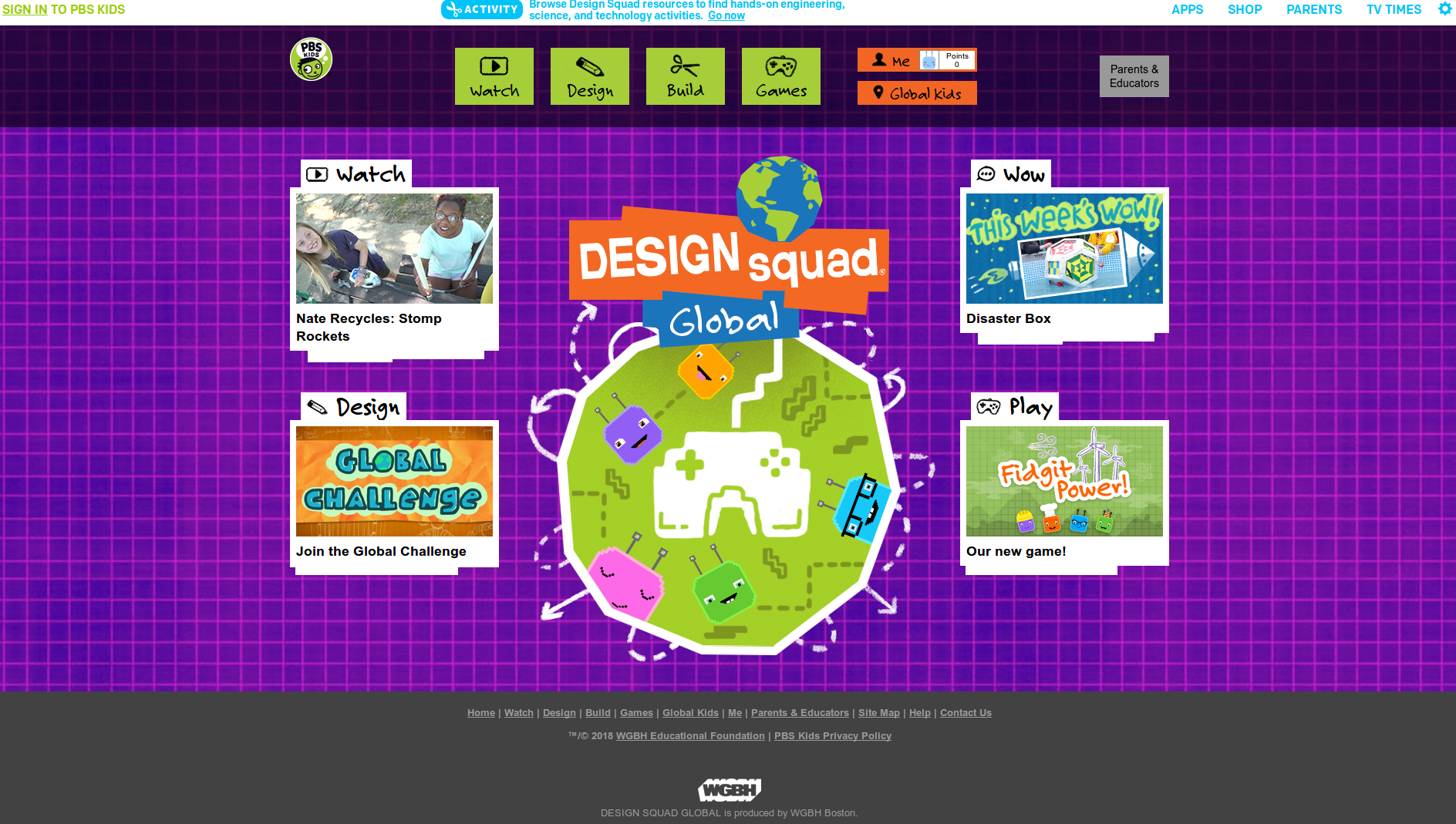
Design Squad
https://pbskids.org/designsquad/
Design Squad is an engineering website based on a US TV show on PBS about people solving problems through engineering. Design Squad has videos to watch, crafts to make which are graded into easy, medium and hard levels, and online games to play. Some less important videos are geoblocked, but those which supplement the crafts are visible from Australia. A login is required, but only a username is given to the site.
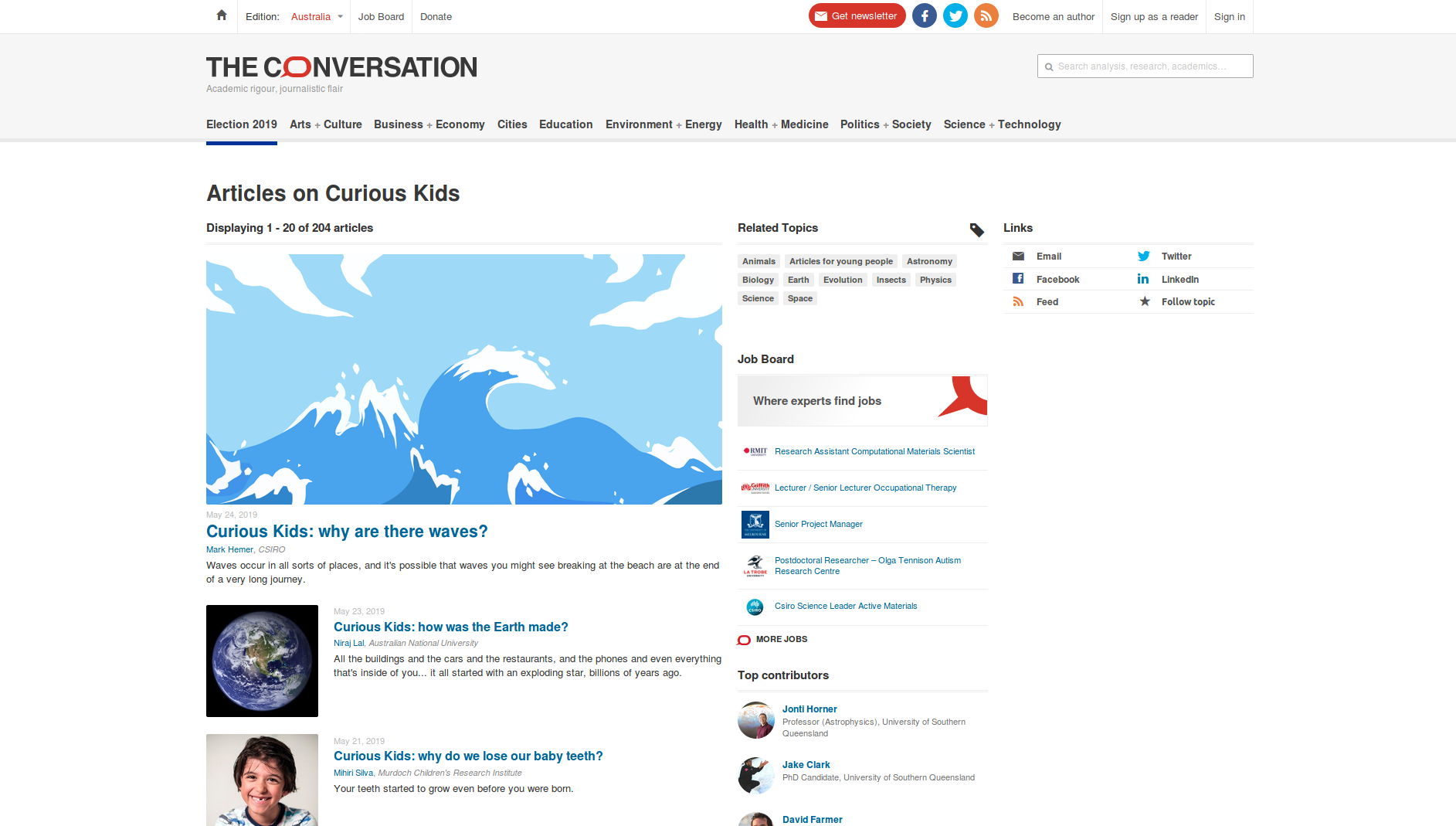
Curious Kids
https://theconversation.com/au/topics/curious-kids-36782
Curious Kids is a segment of The Conversation, a website which aims to provide informative journalistic articles written by academic experts. Curious Kids allows children (with their parents) to write in to The Conversation, and their question will be given to an academic expert to answer in an age-appropriate but rigorous way. Questions have included: do snails fart? or 'how do you know if your cat likes you?' or 'why do we lose our baby teeth?' Questions are often accompanied by videos and interesting pictures to help explain the answer. Some questions have also been turned into podcasts by the ABC, which are useful for long car trips. It's great to browse others' questions, and it's great for inspiring kids to sit down and have a think about what they really want to know.